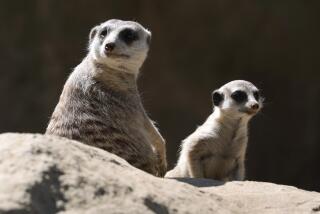Natural-Food Diets Found to Improve Health : Animals in Zoo Dine Their Way to Well-Being
- Share via
SAN DIEGO — The sight of several San Diego Zoo employees busily mincing and dicing fruit for a colony of lion-tailed macaques three years ago got the zoo’s animal behaviorist Don Lindburg to thinking.
“Why are we doing all of this?” Lindburg wondered, noting that animals in native habitats spend most of their waking hours hunting or looking for food, but in captivity have very little to keep them active.
Lindburg decided to explore the pluses and minuses of giving the animals whole fruits and vegetables rather than the labor-intensive processed meals traditionally served to primates in zoos.
At first, some keepers were afraid that the bigger macaques--a species of short-tailed monkey--would grab the whole oranges and apples being substituted for the sliced portions. But hoarding proved no problem. Rather, the animals quickly exhibited much greater activity and enthusiasm for their food, tossing items from hand to foot and, by having to peel the fruit and prepare their own portions, spending much more time on feeding.
“So we ended up giving the animals more activity, considerably increasing their interest in food, and reducing the preparation time required of our own employees,” Lindburg said.
Now, Lindburg and others have additional studies under way to show that the packaging and presentation of food for captive animals have important psychological and physical effects. The Los Angeles Zoo is among others considering the approach already taken by zoos in San Diego, Dallas and Detroit to improve the feeding habits of their animals.
More Than Just Nuturition
“We’re trying to show that the non-nutritive aspects of food should be considered to as great an extent as possible, to try to approximate what animals get in nature,” Lindburg said.
Ongoing work with cheetahs at the zoo’s Wild Animal Park has shown that commercial food preparations now fed to many animals--especially carnivores--result in oral health problems because the soft, formulated foods do not give the large cats adequate gum massaging and exercising of the jaw.
In a 1982 survey that was published recently, 15 of 20 cheetahs in captivity that were fed the commercial diets had their palates perforated by lower molars, resulting in serious nasal and mouth infections. There were no similar palate problems among 39 cheetahs fed animal carcasses, which required the cheetahs to rip and pull through the tough hide to reach chunks of flesh.
“In addition, we’ve noticed improved appetites, a greater tenacity about possession of food, and sometimes even bouts of play centered around the carcass,” Lindburg said. “This contrasts with behaviors suggesting that formulated foods are sometimes barely palatable. I’ve never seen a cheetah play with a chunk of Zu/Preem,” a widely used commercial, formulated food.
Lindburg had a graduate student this summer film a group of cheetahs at the Wild Animal Park to document the contrast in feeding behavior between meals of soft commercial horse meat--such as Zu/Preem--and carcasses of cow fetuses.
“Julie Bond (the student) is watching to see how much gusto, how much licking, how much the animals go at a carcass compared to the commercial food, to see the number of chews per swallow, the time lapse between placement of food and the start of eating,” Lindburg said.
Problems in Captivity
While other large cats--including tigers, lions and leopards--do not show the exact same palate problems, they all habitually exhibit an amazing set of oral health problems in captivity. The same species show almost no dental disease while undergoing quarantine checks when they arrive from the wild.
“The commercial food, while nutritionally balanced, is soft and mushy in terms of consistency, like giving the animals thawed-out hamburger from the freezer,” said Duane Ullrey, professor of comparative nutrition in the animal science department at Michigan State University. Ullrey consults with numerous zoos, including those at Dallas and San Diego, on improving feeding procedures.
“There is no hassle factor for the animals with this food compared with what they consume in the wild, where they have hide and sinew and bone to cut through,” Ullrey said. “And that means (the soft food) does not gloss or brush the teeth so, as a consequence, plaque tends to accumulate on the teeth. And that irritates the gums and produces inflammation and an opportunity for bacteria to invade soft tissues.”
Ullrey said that inflammation can also lead to the deterioration of jawbones and loosening of the teeth--making chewing even more difficult.
The increase in health problems can lead to shorter life spans for these animals. And because many of the species are endangered in the wild, they are extremely difficult to procure as replacements for those that die in captivity.
Ullrey has recommended to his clients that, as one change, they provide chew bones twice a week to carnivorous animals to try to control the plaque problem. While not a perfect solution, he said that some studies have shown fewer oral problems with animals given meat and bones, compared to those given just commercially prepared meat.
Pellets for Herbivores
Ullrey said that physical health problems are less in herbivorous animals such as giraffes, deer and elephants because the hay and pellets given them in zoos have a consistency similar to the natural foods they eat in the wild.
“In a way, the problem is (more pronounced) in carnivores because it is hard to mix all the various meat products and nutrients in a presentable way for the feeding process,” Ullrey said.
Of course, the researchers concede that public acceptance could be a limiting factor in how far zoos can go in providing more natural diets to animals. Lindburg said that zoo visitors might not react favorably to the sight of large cats chewing on horse carcasses or discarded pets.
“In Europe, the zoos are perhaps more realistic (in terms of feeding),” Lindburg said. “You go to (tiger and lion) houses there and you see them gnawing on the hinds of horses.”
Lindburg stresses that providing animals natural foods for better physical health also brings greater psychological benefits. He believes that animals receive much more pleasure in consuming such foods.
“Sure, animals will eat the commercial stuff, but that doesn’t mean they are enthusiastic about it,” Lindburg said. “It hit me when I went to South Africa to pick up a group of cheetahs at a park. I heard the bones popping as the cheetahs were eating calf carcasses and saw how the specialized teeth were being put to use and saw the tug-of-wars.
“The man in charge there said that the eating evoked the wild in captive cheetahs. I agree with him.”
More to Read
Sign up for Essential California
The most important California stories and recommendations in your inbox every morning.
You may occasionally receive promotional content from the Los Angeles Times.













